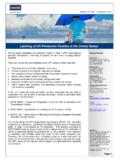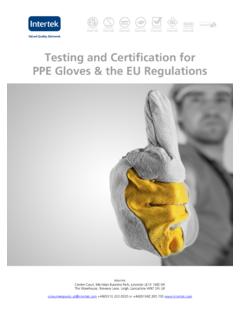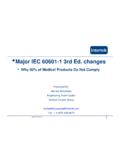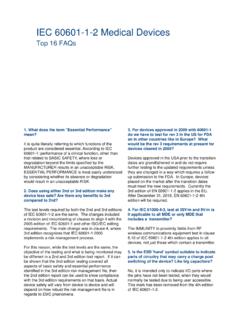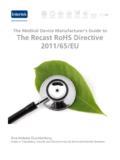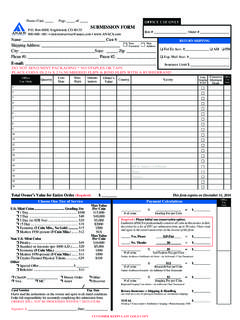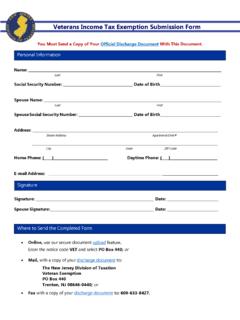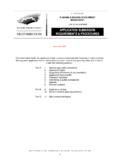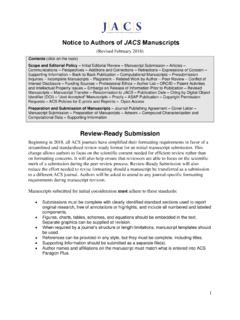Transcription of Guide to Building a Successful 510(k) Submission
1 Guide to Building a Successful 510(k) Submission Daniel W. Lehtonen Sr. Staff Engineer - Medical Devices intertek 70 Codman Hill Road Boxborough, MA. 1-800-WORLD-LAB Introduction Shortening time to market is important to the bottom line of medical device manufacturers worldwide. Selling medical devices in the United States requires product approval through the US Food and Drug Administration (FDA.). On a yearly basis, the FDA sees more than 3,000 submissions through the 510(k) process alone. Devices submitted through other routes, such as the Premarket Approvals (PMA) and Investigational Device Exemptions (IDE) routes, add to their workload. submissions to the FDA that are poorly organized, do not follow current practices, contain inconsistencies between documents or are lacking information, will result in significant delays in the clearance process. The FDA works on a first in first out order. With multiple review cycles, up to 90 days each, device clearance can stretch to 8 months or more.
2 A Submission in which it is difficult for the FDA to find information, or the information is not clear, will slow the process. The FDA does not make interpretations--they will simply ask for revisions and clarifications. Writing and assembling a complete and well structured 510(k) Submission will certainly improve the likelihood of FDA clearance on the first round. You can help yourself by following the suggestions and guidance that FDA provides to the Medical Device Community. intertek , as an Accredited Person, has performed more than 400 reviews of 510(k) submissions and has analyzed the reasons that most often lead to delays in getting submissions ultimately cleared by FDA. The foremost reason for delays is missing content, which can be attributed to poor structure and incomplete content. This white paper focuses on the structure and key elements of the 510(k). Submission and explains in clear language the most common pitfalls to avoid in the development of your 510(k) Submission to the FDA.
3 Structure and General Assembly There is no mandatory form for 510(k) submissions . However, it is suggested that you assemble your Submission following the guidance for Format for Traditional and Abbreviated 510(k) s. 1 This will ensure that you are addressing the topics that FDA expects to see in a Submission , and that you don't accidentally omit a section. Some of the most common omissions / errors are: Unorganized submissions that have missing sections, lack a complete table of contents, and lack tabs for major sections Neglecting to include one copy of the Submission with original signatures on letters and declarations Not utilizing the FDA form for the Indications for Use (you need to mark prescription or Over-the-Counter [OTC] use). Not signing or incorrectly referencing the Code of Federal Regulation (CFR). number for the Truthful and Accurate Statement Incomplete and inaccurate forms, particularly forms 3514 and 3654.
4 Additionally, you should follow all device guidance documents applicable to your device. There may be device specific or topic specific ( software) guidance available. FDA relies upon these guidance documents as stipulated in Section 701(h) of the Federal Food Drug and Cosmetic Act 2 though they are not legally binding. Your goal in putting together your Submission is to provide FDA a complete document, based on facts and science (not opinions and marketing), that is easy to follow and clearly explains how you came to the decision that your device is substantially equivalent to the predicate device. Remember, you are not selling your device to FDA--you are explaining and supporting equivalence. The following list of items is from the guidance for Format for Traditional and Abbreviated 510(k) s. If a particular section does not apply to your device, you should still leave the section heading in the sequence and include an indication of "N/A" and a brief reason why.
5 1. Medical Device User Fee Cover Sheet (Form FDA 3601). If you submit your 510(k) directly to the FDA, you must include a form 3601. For applications sent through a 3rd Party, such as intertek , you may omit the form. 2. CDRH Premarket Review Submission Cover Sheet This is an optional form that is intended to provide the basic administrative information about the device and the firm submitting the 510(k) Submission . All of the information should be included elsewhere in the Submission . If you do decide to include the form, make sure that all information matches the detailed sections of the Submission . 3. 510(k) Cover Letter The cover letter is a free form document (no FDA form) that encompasses much of the same information as the CDRH Premarket Review Submission Cover Sheet. If you are submitting an electronic copy of the 510(k) Submission , a cover letter is required since you will have to include text stating that the e-copy is an exact copy of the paper version of the Submission .
6 4. Indications for Use Statement Not using the current Indication for Use Forms (ODE 3 or OIVD 4 ) will lead to a delay. Having inconsistent Indications Statements in the Submission will also lead to delays. Make sure that you review all locations in which the statement appears to ensure that they are identical, not similar. Additionally, you should not try to incorporate new indications that are not supported by the predicate or differences that are not fully explained as to how the intended therapeutic or diagnostic effect is impacted. Mixing and matching of predicates can lead to issues if the indications from one device and the technology from another device are combined. This often leads to new types of safety and effectiveness questions and substantially equivalent determination. When picking your predicate device, you should carefully review the intended use of the device and the cleared indications for use, not the labelling, and write your indications accordingly.
7 Even minor differences in language and words can impact the indications statement. 5. 510(k) Summary or 510(k) Statement All submissions must contain either a 510(k) summary or 510(k) statement, but not both. The content of the documents must follow the CFR requirements as appropriate. For 510(k) summaries, do not base your content on that of the predicate devices. Historically, the content of the summaries has been rather light, but FDA is now looking very carefully at summaries to make sure that the content meets the CFR requirements. If you choose to provide a 510(k) statement, the text must be verbatim from the CFR. 6. Truthful and Accuracy Statement All 510(k) submissions must include a Truthful and Accurate Statement in accordance with 21 CFR (k). There are numerous guidance documents that have an incorrect reference to section (j). There is no need to cite the CFR. reference. The recommended format for the statement can be found at: Truthful and Accurate Statement Format 5.
8 7. Class III Summary and Certification A Class III Summary and Certification is very uncommon. There are currently only 44 device types that have gone through the 510(k) process and are Class III. devices. None of the devices are eligible for 3rd Party Review. If you do have a Class III device, the suggested format and content can be found at: Premarket Notification Class III Certification and Summary 6. 8. Financial Certification or Disclosure Statement If your Submission includes clinical studies, FDA form 3674 7 will need to be included, and potentially, Form 3454 8 and 3455 9 . These forms are relatively uncommon in the 3rd Party Review Program as submissions for Class II devices that rely upon clinical data for substantiation are excluded from the program. If you need to include clinical data, you will have to submit directly to FDA. 9. Declarations of Conformity and Summary Reports Standards are becoming more important in 510(k) submissions .
9 The FDA. continues to recognize new standards and current versions of existing standards. Recognized standards provide a more consistent review result. Since FDA has recognized the standards, they are comfortable with the methods and pass/fail criteria. However, it is important to explain how and why you are using a particular standard in the Submission - that is what is being addressed ( safety, effectiveness, performance, etc.) Additionally, you need to review of the FDA's Extent of Recognition of the standard. The extent of recognition will tell you if any specific information needs to be provided. For instance, IEC 60601-1-2. has several points that need to be addressed outside of submitting a declaration or test report. Some standards require the test results be provided, whereas others may just allow a statement of conformance. Most importantly, you must complete the FDA form 3654 10 as this will answer most of FDA's questions regarding the use of the standard.
10 10. Executive Summary The content of this section is intended to provide a summary demonstrating how you came to the conclusion that your device is equivalent to the predicate device. This section should essentially pull the key aspects of the Submission together and provide the reader with a single section to gain an understanding of the device, its intended use, the features that support equivalence, and a summary of the testing performed to demonstrate equivalence and performance. Basically, this section should be a science and fact based reasons for why your device is equivalent. Do not include sales or marketing statements. It is suggested that you look at the FDA Review Memo template and instructions when writing this section. You can find these documents at: 510(k) Review Template 11. 510(k) Review Template Instructions 12. 11. Device Description The description should provide the technical specifications for the device, all models that are being offered (including clear explanation of the differences between them), and accessories or components that are included with the device.

